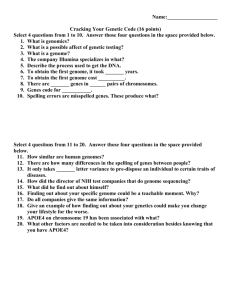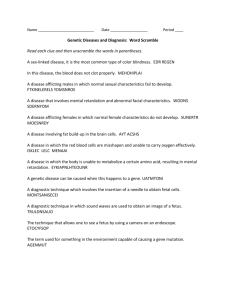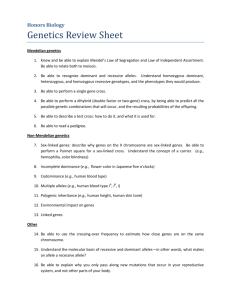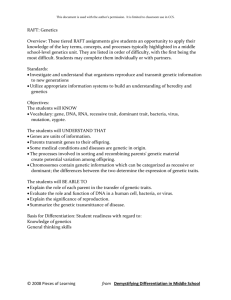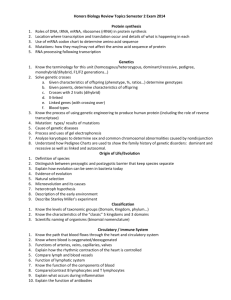Sex linked genes
advertisement
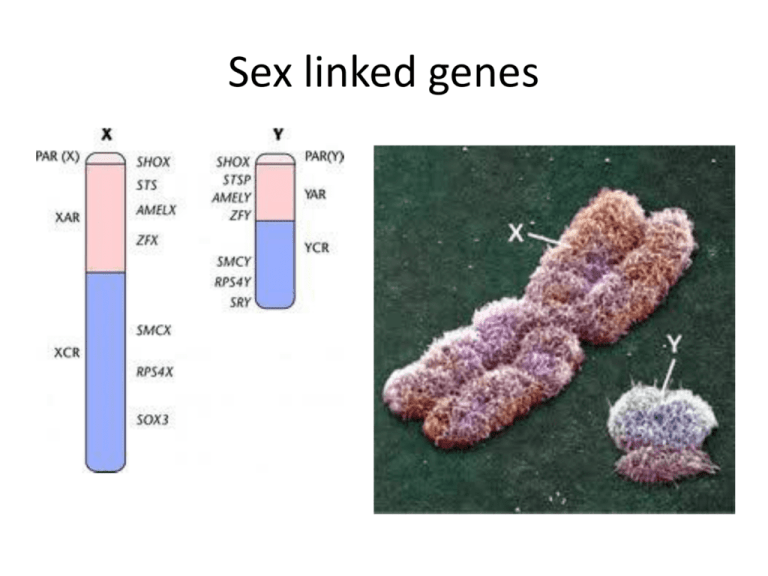
Sex linked genes Why are some characteristics ‘sex linked’? • The X-chromosome 23 carries 1098 genes • Over 100(recessive) genes for genetic disorders have now been mapped to the X-chromosome 23. • The human Xchromosome is much smaller, and only carries a few genes Sex-linked inheritance Red-green colour blindness • test...... Genetics of colour blindness • 0.4% of women are colour blind • 7% of men are colour blind • In colour blindness, green or red cones work poorly, or not at all… • Genes for green and red cones are close to each other on the X-chromosome • Why is ‘blue blindness’ rare? Haemophilia • Recessive, sex linked disease which causes abnormal blood clotting • Individuals are at risk of severe bleeding • Many die from brain haemorrhages • Type A: Lack of Factor VII: 80% of cases of haemophilia • Type B: Lack of Factor IX: 20% of cases Haemophilia in the Royal families of Europe • Queen Victoria has 9 children (4 sons, 2 daughters). She was a carrier for the Haemophilia gene • 1 of 4 sons developed haemohilia (died at age 30) • 2 of 5 daughers were carriers (married and moved to Spain, Russia, Germany) Diseases linked to the 23rd chromosome More than 100 sex-linked genetic disorders have been linked to the X-chromosome of chromosome 23 in humans, including: • Haemophilia • Duchenne Muscular dystrophy • Colourblindness • Melanoma • X-linked severe combined immunodeifciency • X-inactivation centre Why are sex-linked diseases more common in males? 1. Males have only 1 X chromosome; thus all X-linked alleles will be phenotypically expressed in males, even if they are recessive… 2. Females must have BOTH copies of the allele to be recessive, in order to express the gene phenotypically 3. Thus the recessive phenotype of a sex-linked genetic disorder is much more common in males 4. Sex-linked genes can move from fathers to their daughter, where the daughters will be unaffected carriers, but pass the gene to their sons… Inherited Diseases Autosomal Dominant Disorders Neurofibromatosis Huntington’s Disease Autosomal dominant disease: Huntingdon’s Disease Can we test for Huntingdon’s Disease? • Pre-natal testing (amniocentesis or chorionic villus sampling) • Genetic testing after birth Autosomal Recessive Disorders Tay Sachs Cystic Fibrosis Genetic Diseases Inherited diseases • Phenylketonuria • Sickle Cell disease • Cystic fibrosis Cystic Fibrosis Phenylketonuria Sickle Cell Disease Inherited diseases Genetic Testing (1) • How to read a chromosome Genetic Testing (2) There are various types of genetic testing: 1. Prenatal 2. Newborn Screening (e.g. newborn test for PKU) 3. Carrier diagnosis for couples with a family history of disease 4. Late-onset disorders can be tested at any time 5. DNA fingerprinting Genetic Testing and Counseling Diagnosis of carriers – Biochemical (i.e. Tay-Sachs) – Genetic (i.e. Huntington’s disease) – Ethical considerations Fetal diagnosis – Amniocentesis – Chorionic villi sampling Chorionic villi sampling Chorionic villus sampling (CVS) is the removal of a small piece of tissue (chorionic villi) from the uterus during early pregnancy to screen the baby for genetic defects. A son with cystic fibrosis (autosomal recessive) is born to a couple who appear to be normal. What are the chances that any child born to this couple will have cystic fibrosis? And the Answer is….. 25% In humans the allele for short fingers is dominant over that for long fingers. If a person with short fingers who had one parent with long fingers reproduces with a person having long fingers, what are the chances of each child having short fingers? And the Answer is….. 50% Homework: Complete the remain questions on the genetics problem set and do your genetics mini project. Combining multiplication and addition rules to solve complex problems • An organism with the genotype BbDD is mated with one with the genotype BBDd. Assuming independent assortment of these two genes, what is the probability that you will get a BBDD offspring? • ¼ BBDD
